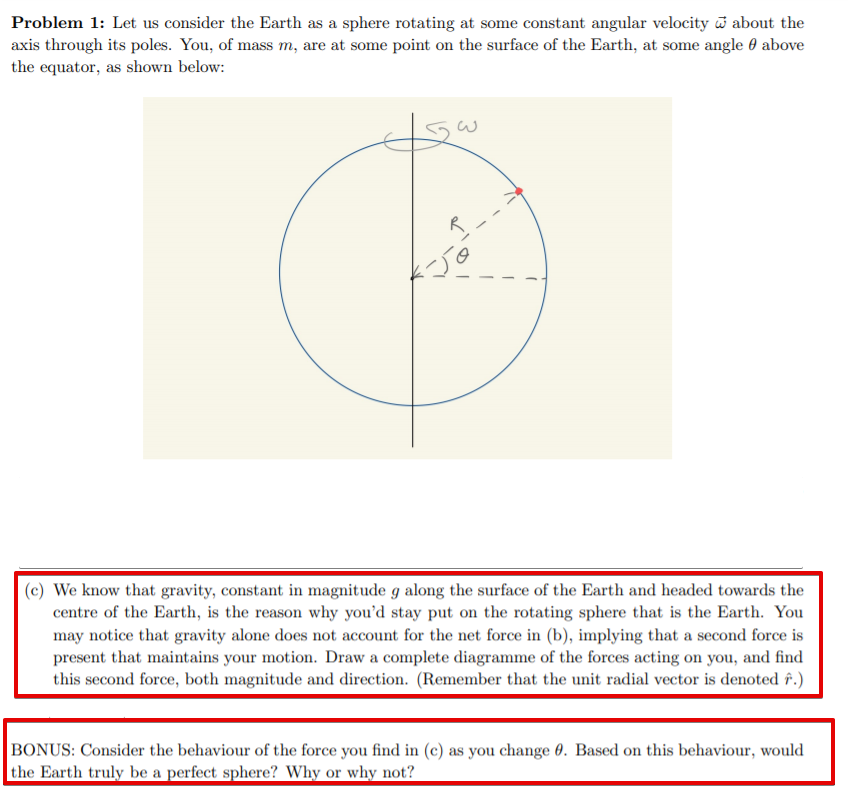(c) We know that gravity, constant in magnitude g along the surface of the Earth and headed towards the centre of the Earth, is the reason why you'd stay put on the rotating sphere that is the Earth. You may notice that gravity alone does not account for the net force in (b), implying that a second force is present that maintains your motion. Draw a complete diagramme of the forces acting on you, and find this second force, both magnitude and direction. (Remember that the unit radial vector is denoted î.) BONUS: Consider the behaviour of the force you find in (c) as you change 0. Based on this behaviour, would the Earth truly be a perfect sphere? Why or why not?
(c) We know that gravity, constant in magnitude g along the surface of the Earth and headed towards the centre of the Earth, is the reason why you'd stay put on the rotating sphere that is the Earth. You may notice that gravity alone does not account for the net force in (b), implying that a second force is present that maintains your motion. Draw a complete diagramme of the forces acting on you, and find this second force, both magnitude and direction. (Remember that the unit radial vector is denoted î.) BONUS: Consider the behaviour of the force you find in (c) as you change 0. Based on this behaviour, would the Earth truly be a perfect sphere? Why or why not?
University Physics Volume 1
18th Edition
ISBN:9781938168277
Author:William Moebs, Samuel J. Ling, Jeff Sanny
Publisher:William Moebs, Samuel J. Ling, Jeff Sanny
Chapter13: Gravitation
Section: Chapter Questions
Problem 86CP: Using Figure 13.9, carefull sketch a free body diagram for the case of a simple pendulum hanging at...
Related questions
Question
Need help with part C and and the bonus practice questions

Transcribed Image Text:Problem 1: Let us consider the Earth as a sphere rotating at some constant angular velocity ở about the
axis through its poles. You, of mass m, are at some point on the surface of the Earth, at some angle 0 above
the equator, as shown below:
(c) We know that gravity, constant in magnitude g along the surface of the Earth and headed towards the
centre of the Earth, is the reason why you'd stay put on the rotating sphere that is the Earth. You
may notice that gravity alone does not account for the net force in (b), implying that a second force is
present that maintains your motion. Draw a complete diagramme of the forces acting on you, and find
this second force, both magnitude and direction. (Remember that the unit radial vector is denoted î.)
BONUS: Consider the behaviour of the force you find in (c) as you change 0. Based on this behaviour, would
the Earth truly be a perfect sphere? Why or why not?
Expert Solution
This question has been solved!
Explore an expertly crafted, step-by-step solution for a thorough understanding of key concepts.
Step by step
Solved in 2 steps with 2 images

Knowledge Booster
Learn more about
Need a deep-dive on the concept behind this application? Look no further. Learn more about this topic, physics and related others by exploring similar questions and additional content below.Recommended textbooks for you

University Physics Volume 1
Physics
ISBN:
9781938168277
Author:
William Moebs, Samuel J. Ling, Jeff Sanny
Publisher:
OpenStax - Rice University

Classical Dynamics of Particles and Systems
Physics
ISBN:
9780534408961
Author:
Stephen T. Thornton, Jerry B. Marion
Publisher:
Cengage Learning

Modern Physics
Physics
ISBN:
9781111794378
Author:
Raymond A. Serway, Clement J. Moses, Curt A. Moyer
Publisher:
Cengage Learning

University Physics Volume 1
Physics
ISBN:
9781938168277
Author:
William Moebs, Samuel J. Ling, Jeff Sanny
Publisher:
OpenStax - Rice University

Classical Dynamics of Particles and Systems
Physics
ISBN:
9780534408961
Author:
Stephen T. Thornton, Jerry B. Marion
Publisher:
Cengage Learning

Modern Physics
Physics
ISBN:
9781111794378
Author:
Raymond A. Serway, Clement J. Moses, Curt A. Moyer
Publisher:
Cengage Learning